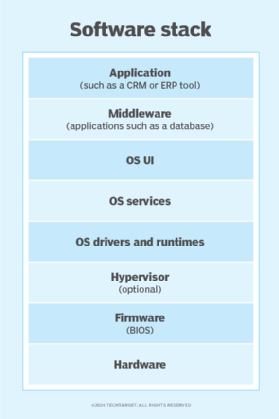Other examples of system software include the following:

- The BOS (basic input/output system) gets the computer system started after it’s turned on and manages the data flow between the OS and attached devices, such as the hard drive, video adapter, keyboard, mouse and printer.
- The boot program loads the OS into the computer’s main memory or random access memory (RAM).
- An assembler takes basic computer instructions and converts them into a pattern of bits that the computer’s processor can use to perform its basic operations.
- A device driver controls a particular type of device that is attached to your computer, such as a keyboard or mouse. The driver program converts the more general I/O instructions of the OS to messages that the device type can understand.
Additionally, system software can also include system utilities, such as the disk defragmenter and System Restore, and development tools, such as compilers and debuggers.
Operating systems
The computer’s OS is a well-known example of system software. Widely used operating systems include Microsoft Windows, macOS and Linux. Unlike other system software types, the average computer user regularly interacts with the computer OS through its graphical UI (GUI) and, with some operating systems, a less complex command-line interface (CLI).
Because a GUI is a program that sits on top of the OS, it may be referred to as application software, not system software. In other words, the GUI is application software that makes it possible for the user to manipulate parts of the OS.
Important tasks performed by the operating system
The main responsibility of the operating system is to manage a computer’s software and hardware resources. It is the computer’s main control program. The OS controls and maintains a record of all other programs on the computer, including both application and system software. The OS creates an environment that all other computer programs run within and provides service to those other applications.
Operating systems perform tasks. Five of the most important ones are the following:
- File management and process scheduling. The OS allocates resources and prioritizes which programs should receive the resources and in what order. For example, a digital audio workstation application may require a certain level of processing power when being used. The OS decides how much power the application gets from the CPU and manages the effects of that allocation on other applications. If a more critical process is happening elsewhere on the computer, the OS might sacrifice some of the power the digital audio workstation has requested, for example, to ensure the other process can be completed.
- Processor and memory management. The OS allocates the computer’s memory to a process when needed and deal locates it when the process is finished.
- Error detection. The OS detects, tracks and debugs errors in the computer’s other programs.
- Security. The OS uses passwords to protect the computer’s programs and data from unauthorized access.
- Control and management. The OS uses compilers, assemblers and interpreters to control and manage other programs on the computer. These language processers are pieces of system software that translate the high-level languages — Java, Python and C++ — that many computer programs are written in into low-level machine code instructions, which is essentially a series of 1s and 0s that the computer’s CPU can read.

